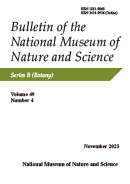We recorded new localities of Oreorchis coreana Finet in Japan, which had been recognized as a rare endemic species in Korea. The new records show a continuous distribution from Jeju Island, Korea to Kyushu, Shikoku, and Honshu, Japan. All of these habitats are situated in upper warm-temperate to lower cool-temperate climates at elevations of approximately 400 to 1200 m and are either deciduous broad-leaved forest or temperate coniferous forests. We found several discriminating characters of this species from the closely related O. patens (Lindl.) Lindl. Among these, differentiation in the pollination system between the two species is remarkable. Oreorchis patens is zoophilous with a conventional orchid pollination system in which the pollinia with adhesive structure is transferred by a pollinator, whereas O. coreana relies on automatic self-pollination conducted by rotation of the stipe connecting pollinia and column. This movement associates with the deposition of pollinia on the stigma. This represents characteristic evolution of reproductive organs found in several members of subtribe Calypsoinae to which O. coreana belongs. Furthermore, macromolecular characters demonstrated that intraspecific differentiation occurs between western (Jeju Island and Kyushu) and eastern (Shikoku and Honshu) populations in this species.
View full abstract
